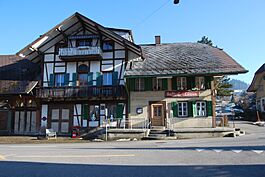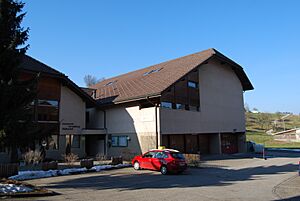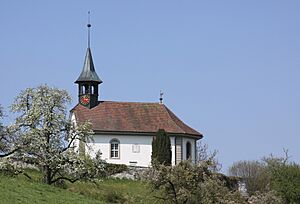Walterswil, Bern facts for kids
Quick facts for kids
Walterswil
|
||
|---|---|---|
 |
||
|
||
| Country | Switzerland | |
| Canton | Bern | |
| District | Oberaargau | |
| Area | ||
| • Total | 7.87 km2 (3.04 sq mi) | |
| Elevation | 658 m (2,159 ft) | |
| Population
(Dec 2020 )
|
||
| • Total | 540 | |
| • Density | 68.6/km2 (177.7/sq mi) | |
| Postal code |
4942
|
|
| Surrounded by | Affoltern im Emmental, Dürrenroth, Oeschenbach, Rohrbachgraben, Ursenbach, Wynigen | |
Walterswil is a small town, also called a municipality, in Switzerland. It's located in the Oberaargau area within the Canton of Bern.
Contents
Exploring Walterswil's Past
Walterswil was first mentioned in old records in the year 1139. Back then, it was called Walterswile.
A noble family, the Freiherr von Walterswil, lived here until the early 1300s. After this family ended, other local nobles owned parts of the area. The village church, dedicated to Saint Cecilia, was first mentioned in 1275.
In 1438, a person named Henman von Spiegelberg gave Walterswil to the city of Bern. This gift included the village, its court, and the right to choose the church's priest. Bern then divided Walterswil among several nearby courts.
Later, in 1798, French forces invaded Switzerland. Walterswil became part of a new district called Unteremmental. After some changes in government, it joined the Trachselwald District in 1803. Finally, in 1888-89, Walterswil gained land from Ursenbach, which made the town the size it is today.
For a long time, the main way people made a living here was through farming. In the 1700s and 1800s, some people also wove canvas at home. Today, many residents travel to work in bigger towns nearby. However, about 71% of the jobs in Walterswil are still in agriculture, meaning farming and related activities.
Discovering Walterswil's Landscape
Walterswil covers an area of about 7.9 square kilometers (3 square miles). A survey from 2006 showed how the land is used. About 74.1% of the land is used for farming. This includes growing crops and raising animals on pastures.
About 21.2% of the area is covered by forests. The remaining 5.1% of the land is settled, meaning it has buildings or roads. Homes and other buildings make up 2.7% of the area, and roads take up 2.4%.
The municipality of Walterswil includes the main village of Walterswil. It also has smaller groups of houses called hamlets, like Schmidigen and Mühleweg. There are also farmhouses grouped together at Wiggisberg and other individual farms.
In 2010, Walterswil became part of a new administrative area called Verwaltungskreis Oberaargau. This change helped organize how the region is managed.
Walterswil's Coat of Arms
The official design of Walterswil's coat of arms is described as: "Silver shield with three red, flaming, jagged branches standing upright." This symbol represents the town.
Walterswil's People and Population
Walterswil has a population of about 541 people as of December 2012. A small number of these residents, about 1.7%, are foreign nationals. Between 2010 and 2012, the population changed slightly, growing by 0.2%. More people moved into the town than moved out.
Most people in Walterswil speak German as their first language. A small number speak Albanian or French.
In 2013, the population was almost evenly split between males (50.8%) and females (49.2%). Most residents were born in Walterswil or elsewhere in Switzerland.
Young people, aged 0 to 19, make up 24% of the population. Adults, aged 20 to 64, are 56.6% of the population. Seniors, over 64 years old, make up 19.4%.
In 2000, about 53.1% of the people living in Walterswil were also born there. Most households had only one person, or five or more people.
The chart below shows how Walterswil's population has changed over many years:

Walterswil's Economy and Jobs
In 2011, Walterswil had a very low unemployment rate of 0.33%. This means almost everyone who wanted a job had one.
The town had 214 people working in different areas. Most jobs were in the primary economic sector, which includes farming. There were 141 people working in this area.
The secondary sector, which involves manufacturing and construction, employed 22 people. The tertiary sector, which includes services like sales, transportation, hotels, and education, employed 51 people.
Many residents of Walterswil travel to other towns for work. In 2000, 156 people left Walterswil to work elsewhere, while only 15 people came into Walterswil for work. Most people who work in Walterswil also live there.
About 55.4% of working people used a private car to get to their jobs. Only 3.4% used public transportation.
In 2011, a small part of the population, 2.7%, received financial help from the government.
Religious Life in Walterswil
According to the 2000 census, most people in Walterswil, about 92.7%, belonged to the Swiss Reformed Church. A very small number, 0.5%, were Roman Catholic.
Some people belonged to other Christian churches. About 0.92% of the population did not belong to any church or did not answer the question.
Learning and Education in Walterswil
In Walterswil, about 57.9% of the population has finished non-mandatory upper secondary education. This means they continued their schooling after the required years. About 12.2% have gone on to higher education, like university.
The Canton of Bern has a school system that starts with one year of optional kindergarten. After that, children attend six years of primary school. Then, there are three years of lower secondary school. In secondary school, students are grouped based on their abilities. After lower secondary school, students can choose to continue their education or start an apprenticeship to learn a trade.
During the 2012-13 school year, 69 students attended classes in Walterswil. There were 13 students in German-language kindergarten classes. The primary school had 33 students in German-language classes. Some of these primary students were permanent or temporary residents of Switzerland.
In the same year, 23 students from Walterswil attended lower secondary schools in nearby towns. In 2000, most students who went to school in Walterswil also lived there.
See also
 In Spanish: Walterswil (Berna) para niños
In Spanish: Walterswil (Berna) para niños










